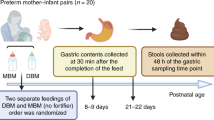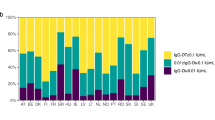Abstract
Objective:
To (1) determine the proportion of mothers and infants who had levels of IgG antibody to pertussis antigens predicted to be potentially protective at delivery; (2) evaluate the efficiency of maternal–infant antibody transport; (3) extrapolate infant antibody titers at 6 weeks; and (4) identify maternal factors associated with potentially protective infant antibodies.
Study Design:
Sera from mother–infant pairs from February 2006 through to April 2007 were tested for antibody to pertussis antigens by standardized ELISA (enzyme-linked immunosorbent assay). Potentially protective antibody levels were defined as >5 ELISA units (EU) for pertussis toxin (PT), and >10 EU for fimbriae (FIM) and pertactin (PRN). Serological evidence of previous maternal infection was defined from antibody to four antigens by k-means cluster analysis.
Result:
In total, 21% (17/81) of mothers and 26% (21/81) of infants had potentially protective antibody levels at delivery. Mean infant–maternal antibody ratios for PT, FIM and PRN were 1.26, 1.36 and 1.31, respectively. At 6 weeks, 11% (9/81) of infants were predicted to have potentially protective antibody levels. Using cluster analysis, 9% (7/81) of mothers had evidence of previous pertussis infection. Infants born to these mothers were predicted to be more likely to have potentially protective antibodies at 6 weeks (43%) than those born to mothers without previous infection (8%) (P=0.03).
Conclusion:
Approximately 75% of infants were born with pertussis antibody levels lower than the modest levels associated with potential protection. Despite effective antibody transfer, nearly 90% of infants were predicted to have little antibody by 6 weeks. Maternal immunization before or during pregnancy might simulate previous pertussis infection and help protect infants through the first months of life.
This is a preview of subscription content, access via your institution
Access options
Subscribe to this journal
Receive 12 print issues and online access
$259.00 per year
only $21.58 per issue
Buy this article
- Purchase on Springer Link
- Instant access to full article PDF
Prices may be subject to local taxes which are calculated during checkout

Similar content being viewed by others
References
Cherry JD . The epidemiology of pertussis: a comparison of the epidemiology of the disease pertussis with the epidemiology of Bordetella pertussis infection. Pediatrics 2005; 115 (5): 1422–1427.
Edwards KM . Overview of pertussis: focus on epidemiology, sources of infection, and long term protection after infant vaccination. Pediatr Infect Dis J 2005; 24 (6 Suppl): S104–S108.
Wood N, McIntyre P . Pertussis: review of epidemiology, diagnosis, management and prevention. Paediatr Respir Rev 2008; 9 (3): 201–211.
Centers for Disease Control and Prevention. In: Atkinson W, Hamborsky J, McIntyre L, Wolfe S (eds). Epidemiology and Prevention of Vaccine-Preventable Diseases, 10th edn, 2nd printing, Public Health Foundation: Washington DC, 2008.
Van Rie A, Wendelboe AM, Englund JA . Role of maternal pertussis antibodies in infants. Pediatr Infect Dis J 2005; 24 (5 Suppl): S62–S65.
Storsaeter J, Hallander HO, Gustafsson L, Olin P . Levels of anti-pertussis antibodies related to protection after household exposure to Bordetella pertussis. Vaccine 1998; 16 (20): 1907–1916.
Cherry JD, Gornbein J, Heininger U, Stehr K . A search for serologic correlates of immunity to Bordetella pertussis cough illnesses. Vaccine 1998; 16: 1901–1906.
Zackrisson G, Arminjon F, Krantz I, Lagergård T, Sigurs N, Taranger J et al. Serum antibody response to filamentous hemagglutinin in patients with clinical pertussis measured by an enzyme-linked immunosorbent assay. Eur J Clin Microbiol Infect Dis 1988; 7 (6): 764–770.
Zackrisson G, Taranger J, Trollfors B . History of whooping cough in nonvaccinated Swedish children, related to serum antibodies to pertussis toxin and filamentous hemagglutinin. J Pediatr 1990; 116 (2): 190–194.
Mooi FR, de Greeff SC . The case for maternal vaccination against pertussis. Lancet Infect Dis 2007; 7 (9): 614–624.
Healy CM, Baker CJ . Prospects for prevention of childhood infections by maternal immunization. Curr Opin Infect Dis 2006; 19 (3): 271–276.
Edwards KM . Pertussis: an important target for maternal immunization. Vaccine 2003; 21 (24): 3483–3486.
Gall SA . Vaccines for pertussis and influenza: recommendations for use in pregnancy. Clin Obstet Gynecol 2008; 51 (3): 486–497.
Murphy TV, Slade BA, Broder KR, Kretsinger K, Tiwari T, Joyce PM et al. Advisory Committee on Immunization Practices (ACIP) Centers for Disease Control and Prevention (CDC). Prevention of pertussis, tetanus, and diphtheria among pregnant and postpartum women and their infants recommendations of the Advisory Committee on Immunization Practices (ACIP). MMWR Recomm Rep 2008; 57 (RR-4): 1–51.
Englund JA . The influence of maternal immunization on infant immune responses. J Comp Pathol 2007; 137 (Suppl 1): S16–S19.
Malek A, Sager R, Schneider H . Maternal-fetal transport of immunoglobulin G and its subclasses during the third trimester of human pregnancy. Am J Reprod Immunol 1994; 32 (1): 8–14.
Meade BD, Deforest A, Edwards KM, Romani TA, Lynn F, O'Brien CH et al. Description and evaluation of serologic assays used in a multicenter trial of acellular pertussis vaccines. Pediatrics 1995; 96: 570–575.
Van Savage J, Decker MD, Edwards KM, Sell SH, Karzon DT . Natural history of pertussis antibody in the infant and effect on vaccine response. J Infect Dis 1990; 161 (3): 473–479.
Healy CM, Munoz FM, Rench MA, Halasa NB, Edwards KM, Baker CJ et al. Prevalence of pertussis antibodies in maternal delivery, cord, and infant serum. J Infect Dis 2004; 190 (2): 335–340.
Wendelboe AM, Van Rie A, Salmaso S, Englund JA . Duration of immunity against pertussis after natural infection or vaccination. Pediatr Infect Dis J 2005; 24 (5 Suppl): S58–S61.
Pickering LK, Baker CJ, Long SS, McMillan JA (eds). Red Book: 2006 Report of the Committee on Infectious Diseases (Red Book Report of the Committee on Infectious Diseases). 27th edn. American Academy of Pediatrics: Elk Grove Village, 2006, Pertussis; p 515.
Edelman K, He Q, Mäkinen J, Sahlberg A, Haanperä M, Schuerman L et al. Immunity to pertussis 5 years after booster immunization during adolescence. Clin Infect Dis 2007; 44 (10): 1271–1277.
Barreto L, Guasparini R, Meekison W, Noya F, Young L, Mills E . Humoral immunity 5 years after booster immunization with an adolescent and adult formulation combined tetanus, diphtheria, and 5-component acellular pertussis vaccine. Vaccine 2007; 25 (48): 8172–8179.
Baughman AL, Bisgard KM, Edwards KM, Guris D, Decker MD, Holland K et al. Establishment of diagnostic cutoff points for levels of serum antibodies to pertussis toxin, filamentous hemagglutinin, and fimbriae in adolescents and adults in the United States. Clin Diagn Lab Immunol 2004; 11 (6): 1045–1053.
Centers for Disease Control and Prevention (CDC). Pertussis—United States, 2001–2003. MMWR Morb Mortal Wkly Rep 2005; 54 (50): 1283–1286.
Halasa NB, O'Shea A, Shi JR, LaFleur BJ, Edwards KM . Poor immune responses to a birth dose of diphtheria, tetanus, and acellular pertussis vaccine. J Pediatr 2008; 153 (3): 327–332.
Healy CM, Baker CJ . Maternal immunization. Pediatr Infect Dis J 2007; 26 (10): 945–948.
Munoz FM, Englund JA . A step ahead. Infant protection through maternal immunization. Pediatr Clin North Am 2000; 47 (2): 449–463.
Zaman K, Roy E, Arifeen SE, Rahman M, Raqib R, Wilson E et al. Effectiveness of maternal influenza immunization in mothers and infants. N Engl J Med 2008; 359 (15): 1555–1564.
Englund JA, Anderson EL, Reed GF, Decker MD, Edwards KM, Pichichero ME et al. The effect of maternal antibody on the serologic response and the incidence of adverse reactions after primary immunization with acellular and whole-cell pertussis vaccines combined with diphtheria and tetanus toxoids. Pediatrics 1995; 96 (3 Pt 2): 580–584.
Jackson LA, Cherry JD, Wang SP, Grayston JT . Frequency of serological evidence of Bordetella infections and mixed infections with other respiratory pathogens in university students with cough illnesses. Clin Infect Dis 2000; 31 (1): 3–6.
Watanabe M, Connelly B, Weiss AA . Characterization of serological responses to pertussis. Clin Vaccine Immunol 2006; 13 (3): 341–348.
Author information
Authors and Affiliations
Corresponding author
Rights and permissions
About this article
Cite this article
Shakib, J., Ralston, S., Raissy, H. et al. Pertussis antibodies in postpartum women and their newborns. J Perinatol 30, 93–97 (2010). https://doi.org/10.1038/jp.2009.138
Received:
Revised:
Accepted:
Published:
Issue Date:
DOI: https://doi.org/10.1038/jp.2009.138
Keywords
This article is cited by
-
Safety and effectiveness of acellular pertussis vaccination during pregnancy: a systematic review
BMC Infectious Diseases (2020)
-
The long-term effects of meteorological parameters on pertussis infections in Chongqing, China, 2004–2018
Scientific Reports (2020)
-
Protecting Newborns Against Pertussis: Treatment and Prevention Strategies
Pediatric Drugs (2015)



